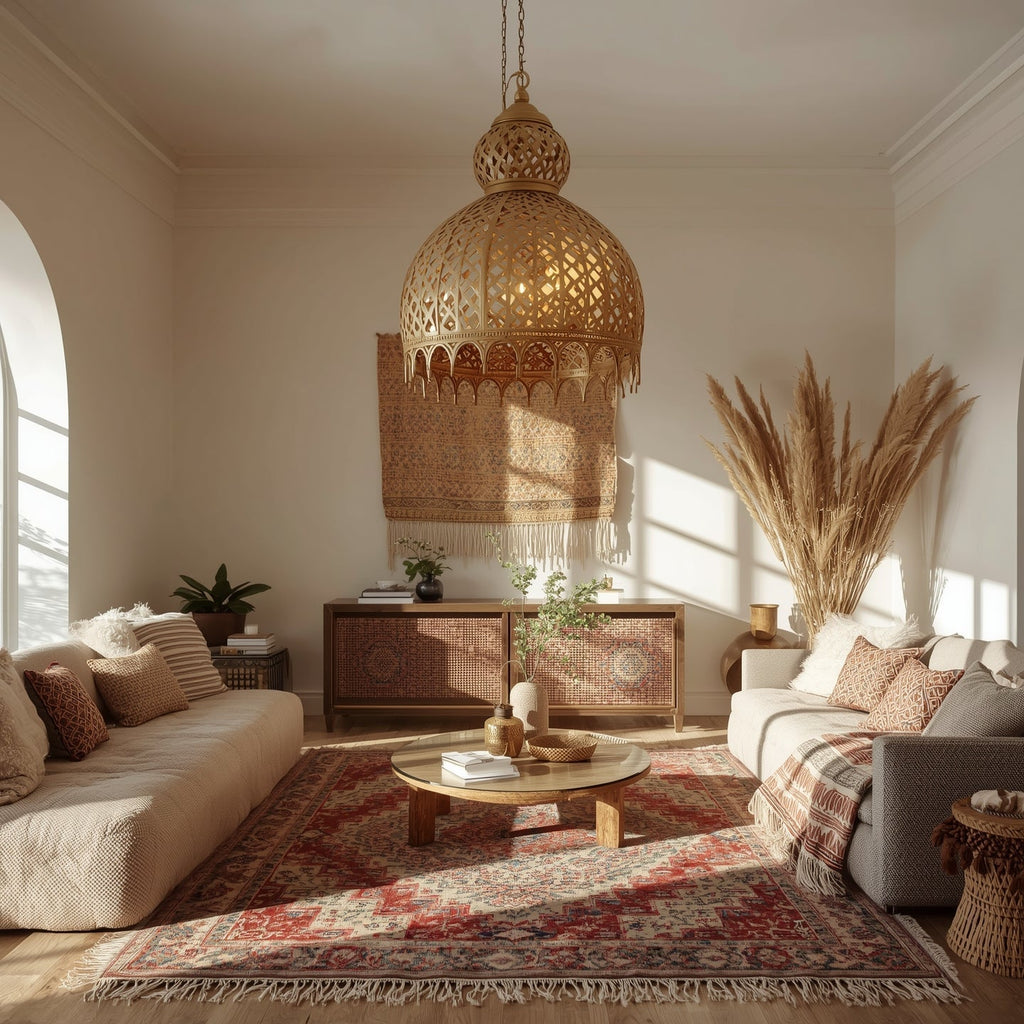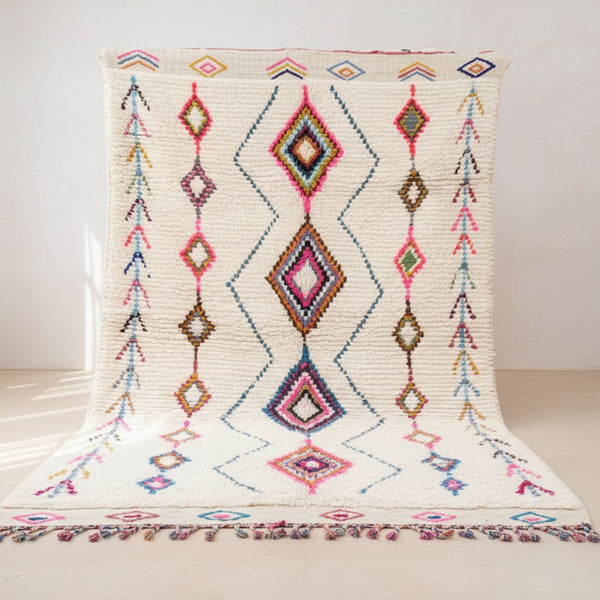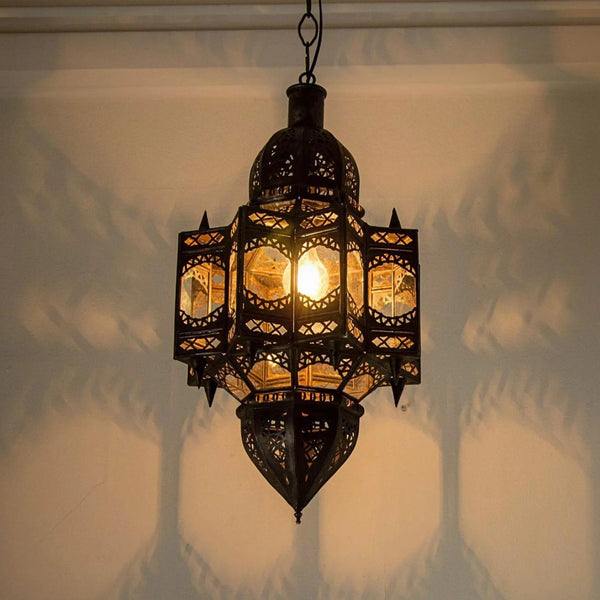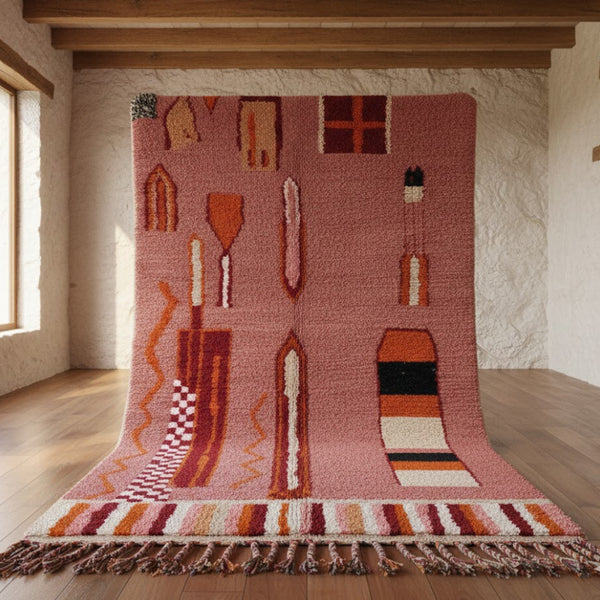The Complete Guide to Moroccan Ceiling Lights: Pairing with Handwoven Rugs
Posted by AADIL KHAN

In interior design today, we're seeing a movement toward spaces that feel personal, layered, and full of culture. Gone are the days of cookie-cutter decor. In their place are artisanal pieces that reflect heritage, texture, and craftsmanship. At the heart of this aesthetic shift are two timeless elements: Moroccan ceiling lights and handwoven rugs like bohemian rugs. Together, they offer warmth, dimension, and a story-rich foundation for any room.
This guide explores how to blend pendant lights and Moroccan textiles with intention—creating rooms that feel both elevated and grounded. Whether you're curating a bold boho loft or a serene reading nook, the interplay of light and texture can transform your home into a sanctuary of style.
Why Pendant Lights Are Essential in Moroccan-Inspired Design

When we talk about Moroccan-inspired interiors, we're really talking about atmosphere—spaces that glow, shimmer, and breathe warmth. That’s why pendant light are so essential. Their ability to cast dramatic, dappled light creates mood like no other fixture can.
In Moroccan design, pendant lights are typically made from brass, pierced metal, or tinted glass. They're often suspended at different heights to layer the lighting effect. More than just functional, they become focal points—hanging art that sets the tone for the space.
You can use pendant lights to highlight architectural elements, like a carved archway or a mosaic floor. Or, group them above a dining table to create intimacy. Their form is sculptural; their function is emotional.
How Moroccan Pendant Lights Set the Mood in Any Room
Moroccan pendant lights do something extraordinary: they don’t just illuminate—they transform. These lights are known for their intricate detailing, often featuring hand-pierced brass or colored glass that filters light in mesmerizing patterns across walls and ceilings.
In living rooms, Moroccan pendant light creates softness and drama. In bedrooms, they can replace standard table lamps for a more romantic, elevated feel. Entryways benefit from their sculptural elegance, offering guests an immediate sense of character.
You’ll find that Moroccan pendant lights bring not only beauty but also intention to a space. Whether you’re after a relaxed bohemian vibe or a sophisticated eclectic mix, these lights help anchor the design language.
The Beauty of Bohemian Rugs Under Moroccan Lighting
There’s something magical about the combination of glowing Moroccan lights overhead and bohemian rugs underfoot. Both are rich in pattern, tradition, and individuality—yet when paired thoughtfully, they don’t compete. They complement.
Bohemian rugs often feature earthy tones, tribal patterns, and distressed textures. Their softness contrasts beautifully with the metalwork and geometry of Moroccan lighting. The result is a space that feels layered and lived-in, without being cluttered.
Use bohemian rugs to ground a space visually while allowing your ceiling lights to draw the eye upward. A low pile rug with muted colors pairs well with ornate pendant lights, while a bold, high-pile rug might call for simpler fixtures to balance the room.
Tips for Pairing Pendant Lighting with Handwoven Rugs

When pairing pendant lights with bohemian rug, start with one hero element—then build around it. For example, if your pendant is elaborate, opt for a more neutral rug. If your rug is bold and colorful, keep your lighting minimal yet warm.
Color coordination matters. Pull tones from your rug into the finish or glass of your pendant light. A rug with golden ochre or rust tones pairs beautifully with antique brass lighting. A rug with cool blues and whites might benefit from a silver-toned or clear glass fixture.
Scale is also important. Large pendant lights need larger rugs to balance the visual weight of the room. And always think in layers—mixing textures like woven wool underfoot with hammered brass overhead gives a tactile richness that’s distinctly Moroccan-boho.
Designing with Texture: Mixing Lighting Materials and Rug Weaves
Texture is the unspoken hero of good design. The interplay of hard and soft, matte and shine, rough and smooth creates rooms that feel dynamic rather than flat.
Pairing a coarse wool rug with a highly polished metal pendant offers contrast that feels intentional. A loosely woven kilim rug under a perforated lantern creates a rhythm of light and shadow that draws people in.
Don’t be afraid to mix materials. Moroccan lighting often includes glass, iron, or brass, while bohemian rugs can be made from wool, cotton, or jute. Layer these textures thoughtfully to create depth.
Best Rooms to Combine Moroccan Ceiling Lights and Artisan Rugs

While any room can benefit from this pairing, some spaces shine brighter than others with the combination of Moroccan pendant lights, pendant lights, and bohemian rugs:
- Living Room: Anchor the sofa with a large bohemian rug, and place a trio of Moroccan pendant lights above the coffee table.
- Bedroom: Use a bold rug beneath the bed and hang a pendant on each side as a soft alternative to bedside lamps.
- Entryway: Set the tone with a patterned rug in the foyer and a single statement pendant above.
- Dining Room: Pair a large pendant light with a rug under the dining table that grounds the space.
These pairings don’t just fill space—they frame it, soften it, and add emotional warmth.
Where to Find Quality Moroccan Pendant Lights and Bohemian Rugs
Authenticity matters. Look for sources that focus on handcrafted goods, fair-trade sourcing, and artisan partnerships.
For Moroccan pendant lights, seek out collections made in Morocco using traditional techniques. Look for hand-cut patterns, aged brass finishes, and natural patinas.
When shopping for bohemian rugs, choose handwoven options made from natural fibers. Vintage or ethically made modern designs offer character and durability.
Conclusion: Layered Style That Lasts
The pairing of Moroccan pendant lights, pendant lights, and bohemian rugs is more than a stylistic choice—it’s a design philosophy rooted in culture, craftsmanship, and intentional living.
These elements bring emotion, texture, and individuality into your home. When chosen and styled thoughtfully, they offer lasting beauty that transcends trend. So whether you’re refreshing a single room or designing an entire home, start with light and texture—and build a space that feels as good as it looks.





